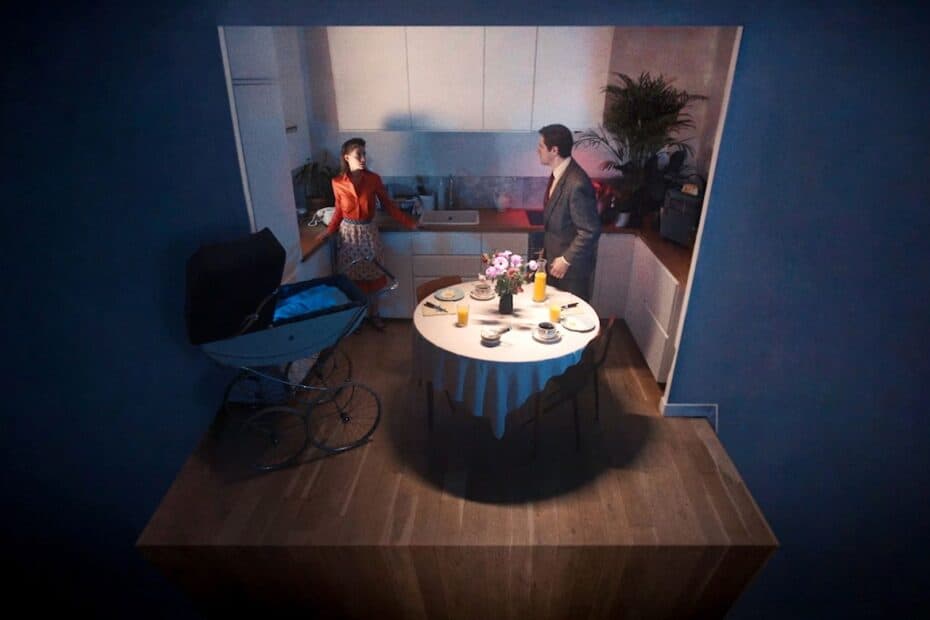This review was not written by an Artificial Intelligence
Where to begin with THE END (artificial fragments of humankind)? Is it possible to make heads or tails of this rabbit hole film at the end or at the beginning? Apparently, it’s the work of three entities: Aurélien Héraud, Olivier Héraud, and A. I GPT4ALL. The film begins (or ends?) with a title announcing, “This film was made by Artificial intelligence.” That statement is followed by an artificial-sounding female voice stating that she made the film on her own. From the outset, it’s obvious that we are dealing with something different here. Then, we are treated to a sunset (It’s not the last time we will see that one), which will shift to being screened on a TV.
Suddenly, we see a row of men sounding off La Marseillaise. This part made me think of the obscure Hungarian film Vattatyúk (1990). That film was stuck in my mind somewhere, but nothing managed to conjure its memory until now, 33 years after I watched it. That might seem like minutiae, but it says something about the impact of the Héraud brothers’ film. We will get to that later. The first sequence involving a dialogue is telling of what kind of film we are watching. Esther tells a story to a friend in a bar involving a weird man to whom she is trying to sell a hammer. Eventually, he will say that he prefers a ukulele.

The Endless imagination of the Héraud brothers
After a while, the friend asks what else “the Mexican” did. Esther, irritatingly, says that she never said that the guy was Mexican and scolds the friend for not listening to her. The interesting point here is that Esther’s story is being visualised for the spectator, and judging by the look of the guy, Mexican is not a surprising statement. Thus, it’s not merely the case that Esther’s nameless friend is not listening to her, but it seems that she is watching the same film as the audience. Does it sound complicated? It will be much more convoluted than that. Is Esther, in fact, controlled by a rabbit? And did she actually run over said rabbit with her car?
It would be facile to apply terms like dream logic to the film, but in many ways, the film has nightmarish implications, not least since it’s a nightmare to try to describe accurately. It’s not that I feel sorry for myself as a critic. Any attempt to publicise or sell this endlessly fascinating work is bound to be almost impossible. No description of this film can do it justice, and it is bound to simplify the experience. New narratives (or what appears to be the genesis of a narrative) are constantly introduced. Characters appear that may become the protagonist but probably will not. I happily gave up on the idea of looking for a main character early on.
THE END still provides a multitude of references that occasionally act as red herrings. My guess is that many spectators (I hope this film will reach many spectators) will try to draw comparisons with David Lynch, but that is far from the answer to unlocking this film. Does it even need to be unlocked in the conventional sense where a cinematic experience is boxed into a verbal one? For marketing purposes, it sure does, and it is to Black Nights Festival credit that they screened this work, which had its world premiere at the L’Étrange Festival in Paris in September. There are meta layers galore in this work, but they never feel redundant or just thrown in.

When I interviewed the directors, they told me that they envisioned a mille-feuille structurally. The final film may not have a thousand layers (neither does the layer cake in question), but it is generously multifaceted and offers more food for thought than the sweet dessert. The experience of watching the film was akin to a whirlwind going through your mind, opening up layers you had forgotten for too long, not limited to Hungarian films. It is a reminder of what cinema is capable of and echoes the thoughts expressed by Mark Jenkin when I talked to him in Cannes about cinematic form.
There are several aspects of THE END that I haven’t touched upon, like the guru-like figure that people stand in line outside to talk to and who charges 100 Euros and some Eurocents for the trouble. That also goes for Lazaridis, who tells his therapist about his fantasies about killing women and the possible connection that could have to a break-in. I feel like I have hardly put the spoon in this delicious mille-feuille. There is an overarching theme of the lack of communication between people. A complaint to a neighbour may, in fact, be the only contact that an individual has with another person.
The main reason for not digging too deeply into those things is that THE END is a work that should be experienced, not read about. Still, thanks for reading. I wrote the whole piece myself without being controlled by a rabbit. What else can I say when he is in the same room as me? I’m including a trailer which may or may not give you some hint about the riches of this extraordinary film. This is a rabbit hole that you are not eager to get out of.

